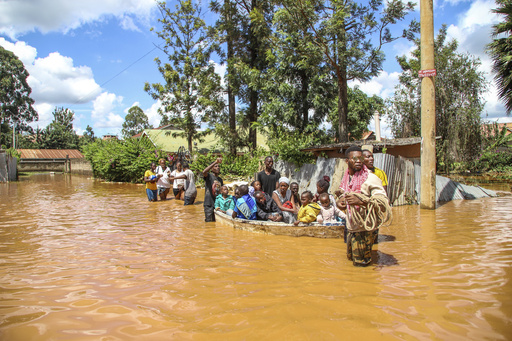NAIROBI, Kenya (AP) — The torrential rains and deadly floods that have hit Kenya since March have been some of the most catastrophic in the country in recent years.
At least 169 people have died due to the heavy rains, with at least 91 missing, according to the latest government figures.
In the most tragic single event, at least 48 people were killed on Monday after water blew through a blocked river tunnel under a railway line in southwestern Kenya, causing a flash flood. The rain has displaced more than 190,000 people and damaged roads and other infrastructure.
The devastating rains are a result of a mix of factors, including the country’s seasonal weather patterns, human-caused climate change as well as natural weather phenomena.
Here’s how they combined to create the deadly deluge.
WHAT IS KENYA’S ‘LONG RAINS’ SEASON?
Kenya and some other parts of eastern Africa have two main rainfall periods: the “long rains” season of March to May, and the “short rains” season of October to December.
The “long rains” season is when most of the country’s average annual rainfall occurs. It’s often characterized by torrential rains, and sometimes goes up to June.
In its forecast for this year’s “long rains” season, the Kenya Meteorological Department predicted above-average rainfall in many parts of the country, with occasional storms in some. It also warned of flash floods, landslides, mudslides and other impacts.
Last year’s “short rains” season was characterized by severe storms in many parts of the country, particularly in November. Lamu, Mombasa and Garissa counties received nearly three times their long-term average rainfall, according to the meteorological department.
WHY IS THE RAIN SO INTENSE THIS TIME?
The frequency, patterns and intensity of rainfall in Kenya are influenced by naturally occurring climate systems like the Indian Ocean Dipole.
The Indian Ocean Dipole is a swinging of sea surface temperatures that makes the western Indian Ocean warmer than average then colder than average than those of the eastern Indian Ocean. It has positive, neutral and negative phases.
The positive phase causes heavy rainfall in areas west of the Indian Ocean, such as Kenya, and droughts in Indonesia and Australia.
While many people have linked the current floods to the naturally occurring El Nino weather phenomenon, research shows that the climate event has little influence on rainfall over East Africa during the “long rains” season, said Joyce Kimutai, research associate at Imperial College London.
El Nino is the warming of the ocean over the Pacific Ocean, which changes the routes for storms and it can cause heavy rainfall in some parts of the world and droughts in others.
But in Kenya’s case, it’s highly likely that the positive Indian Ocean Dipole and climate change explain the ongoing flood-inducing rainfall, she said.
Warmer oceans caused by the hotter atmosphere increase evaporation, and air holding more moisture can produce more intense rainfall.
In an analysis in December last year, Kimutai and colleagues from World Weather Attribution, a group of scientists that analyze whether climate change played a role in extreme weather, found that human-caused climate change had made last year’s “short rains” season in Kenya and other parts of eastern Africa up to two times more intense.
WHEN WILL THE ‘LONG RAINS’ END?
It’s become difficult to predict long-term weather in Kenya in recent years, as the onset and duration of dry and wet seasons increasingly change.
The Kenya Meteorological Department expects the “long rains” season to continue into June.
In its latest seven-day weather forecast, which it released on Monday, the department said it expects rainfall to continue in several parts of the country, with heavy downpour likely to occur in six regions, as well as flooding in low-lying areas and landslides in steep slopes.
___
The Associated Press’ climate and environmental coverage receives financial support from multiple private foundations. AP is solely responsible for all content. Find AP’s standards for working with philanthropies, a list of supporters and funded coverage areas at AP.org.



